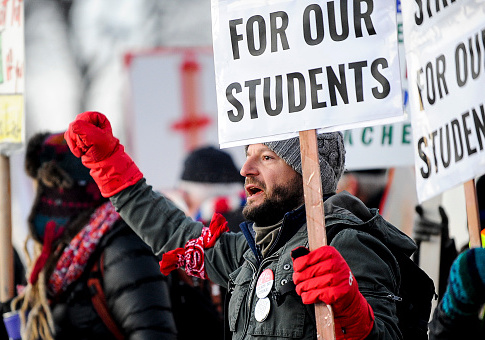Is the education reform movement a den of right wingers? Quite the opposite, a new report from the American Enterprise Institute argues.
In modern policy parlance, "education reform" covers a bevy of proposals—e.g. charter schools, abolishing tenure, or school vouchers—that are meant to increase competition among schools and, conversely, the number of choices available to parents. Because of this, left-leaning critics—especially teachers' unions and their supporters—tend to attack reformists trying to "privatize" education or as being the goons of popular left-wing boogeymen such as the Koch Brothers.
However, new research from Frederick Hess, AEI director of education policy studies, and Jay Greene, University of Arkansas professor of education reform, suggests that education reform advocates are far from a pack of hardcore conservatives. To the contrary, they are not even bipartisan. Rather, using data on the campaign contributions of major education reform groups' employees, the pair of researchers conclude that there is an overwhelming leftward tilt within the group.
"These results paint a surprising picture of education reform: one of a movement dominated by Democratic partisans," Greene and Hess write. "In fact, the school-reform community's leftward tilt is wholly at odds with the popular narrative that school reform is the project of right-wing privatizers—and with reformers' claims that theirs is a centrist, bipartisan movement."
To conduct their study, the two built a list of education reform groups based on education donations from the Bill and Melinda Gates Foundation and the Walton Family Foundation, from which "the lion's share of organizations working in education reform" receive support. They identified 47 organizations in total whose staff had made contributions, including major players like Achieve Inc., Teach for America, and KIPP.
Using campaign contribution data gathered by the Center for Responsive Politics, Greene and Hess concluded that 92 percent of all campaign contributions among the group of interest were made to Democrats. In money terms, out of $2.41 million in contributions identified, $1.95 million was given to Democrats, or 81 percent.
The same phenomenon appears when looking at pro-reform scholars, using the list of all presenters at the most recent meeting of the Association for Education Finance and Policy. 96 percent of their identified contributions went to Democrats, totaling more than $75,000.
By comparison, Greene and Hess note that 90 percent of contributions from Hollywood and public-sector union employees go to Democrats. At the same time, they find that 41 percent of educators are Democrats, compared to 27 percent Republicans and 30 percent independents—meaning the effect is not explained away by the political composition of teachers in general.
What this means, in larger context, is that the conflict over education reform is not really a left-versus-right battle. Rather, it is clearly another struggle between pro-market, pro-reform liberals and the labor/progressive left.
"The bottom line: The leading participants in the school-reform 'wars' are mostly engaged in an intramural brawl, one between union-allied Democrats and a strand of progressive Democrats more intent on changing school systems," the authors write.
This, they argue, could hamper efforts to actually fix America's school systems. An education reform movement defined by an intra-left dispute is one that excludes the views of more moderate or conservative advocates—to the detriment, Greene and Hess contend, of schools and children as a whole.
